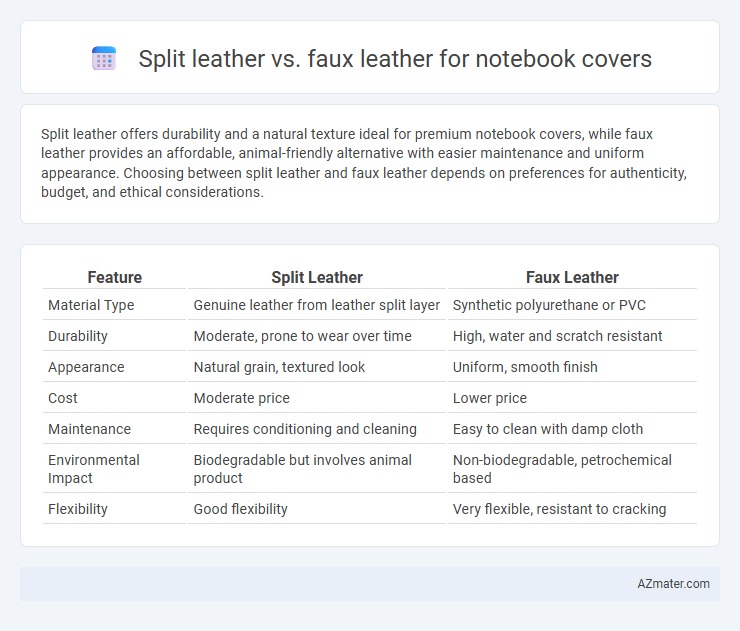Split leather offers durability and a natural texture ideal for premium notebook covers, while faux leather provides an affordable, animal-friendly alternative with easier maintenance and uniform appearance. Choosing between split leather and faux leather depends on preferences for authenticity, budget, and ethical considerations.
Table of Comparison
| Feature | Split Leather | Faux Leather |
|---|---|---|
| Material Type | Genuine leather from leather split layer | Synthetic polyurethane or PVC |
| Durability | Moderate, prone to wear over time | High, water and scratch resistant |
| Appearance | Natural grain, textured look | Uniform, smooth finish |
| Cost | Moderate price | Lower price |
| Maintenance | Requires conditioning and cleaning | Easy to clean with damp cloth |
| Environmental Impact | Biodegradable but involves animal product | Non-biodegradable, petrochemical based |
| Flexibility | Good flexibility | Very flexible, resistant to cracking |
Introduction: Split Leather vs Faux Leather for Notebook Covers
Split leather, derived from the fibrous underside of animal hides, offers a natural texture and greater breathability compared to synthetic alternatives. Faux leather, made from polyurethane or PVC, provides a consistent finish, enhanced water resistance, and is often more affordable and cruelty-free. Choosing between split leather and faux leather for notebook covers depends on preferences for durability, appearance, environmental impact, and budget.
Defining Split Leather: Features and Benefits
Split leather is derived from the lower layers of a cowhide after the top grain is removed, offering a textured surface often coated for durability. It provides enhanced breathability and flexibility, making it ideal for notebook covers that require a soft yet resilient material. While less expensive than full-grain leather, split leather still delivers a natural leather feel combined with increased resistance to wear and tear.
Understanding Faux Leather: Types and Characteristics
Faux leather for notebook covers includes polyurethane (PU) and polyvinyl chloride (PVC) varieties, each offering distinct durability and texture profiles suitable for different preferences. PU leather mimics genuine leather's softness and breathability, making it a popular sustainable alternative for stylish and lightweight covers. PVC leather, on the other hand, provides greater water resistance and longevity but may lack the natural feel and flexibility seen in higher-quality splits.
Visual Appeal and Texture Comparison
Split leather exhibits a natural grain texture with unique imperfections, providing a rich, authentic visual appeal that enhances the luxury of notebook covers. Faux leather offers a consistently smooth surface with uniform patterns, appealing to those seeking a sleek, modern look without natural variance. The tactile experience of split leather is supple and slightly coarse, while faux leather typically feels smoother and more synthetic to the touch.
Durability and Longevity: Which Lasts Longer?
Split leather, derived from the lower layers of animal hides, offers moderate durability but tends to wear faster due to its less dense fiber structure compared to full-grain leather. Faux leather, made from synthetic materials like polyurethane, provides consistent resistance to scratches and water, often lasting longer without cracking or fading under regular use. For notebook covers exposed to daily handling and potential spills, faux leather typically ensures greater longevity and maintenance ease than split leather.
Environmental Impact: Sustainability Considerations
Split leather, derived from the fibrous part of animal hides, involves significant environmental costs due to livestock farming's high water use, methane emissions, and deforestation. Faux leather, typically made from polyurethane or PVC, reduces reliance on animal agriculture but poses sustainability concerns linked to fossil fuel extraction and plastic pollution. Selecting a notebook cover requires balancing animal welfare and carbon footprint against the challenges of synthetic material disposal and microplastic contamination.
Cost Comparison: Budget-Friendly Options
Split leather notebook covers are generally more expensive due to their natural durability and premium quality, offering long-lasting protection and a luxurious feel. Faux leather options provide a budget-friendly alternative, mimicking the look of genuine leather at a lower price point, making them ideal for cost-conscious consumers. Choosing faux leather helps reduce upfront costs while still providing decent durability and style for everyday use.
Maintenance and Care Requirements
Split leather notebook covers require regular conditioning to prevent drying and cracking, as they absorb moisture more easily due to their porous surface. Faux leather covers are generally low-maintenance, needing only occasional wiping with a damp cloth to remove dirt and avoid surface damage. Both materials benefit from moderate protection against direct sunlight and extreme temperatures to prolong their lifespan and appearance.
Ethical Concerns: Animal Welfare and Vegan Alternatives
Split leather is derived from the fibrous lower layer of animal hides, raising ethical concerns related to animal welfare due to the use of animal byproducts. Faux leather, made from synthetic materials such as polyurethane or plant-based alternatives, offers a vegan-friendly option that eliminates animal exploitation. Choosing faux leather for notebook covers supports cruelty-free practices and reduces environmental impacts associated with leather production.
Choosing the Best Notebook Cover: Final Recommendations
Split leather offers durability and natural texture, making it ideal for premium notebook covers that age gracefully over time. Faux leather provides a cost-effective, cruelty-free alternative with consistent appearance and easier maintenance. For lasting quality and authenticity, split leather is recommended, while faux leather suits budget-conscious users seeking an animal-friendly option.

Infographic: Split leather vs Faux leather for Notebook cover
 azmater.com
azmater.com